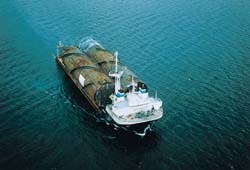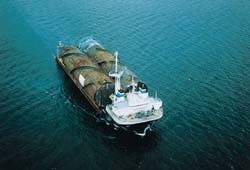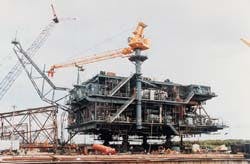Oryx Energy Co. and CNG Producing Co. used the Mighty Servant III to transport Neptune spar's hull in two sections from Pori, Finland, where it was assembled and fabricated by Aker Rauma Offshore, to Ingalls Shipyard at Pascagoula, Miss. (left photo). In photo at right, J. Ray McDermott Inc. (JRM), New Orleans, constructed Neptune spar's topsides at JRM's Morgan City, La., yard. The unit includes a main production deck, mezzanine production deck, and workover deck and can house a permanent crew of 18. Photos courtesy Oryx.Oryx Energy Co., Dallas, and CNG Producing Co., New Orleans, are poised to launch the world's first spar-based offshore oil and gas production system.
Oryx and CNG plan to install the unique floating production system during the next few weeks in 1,930 ft of water on Viosca Knoll Block 826 in the Gulf of Mexico.
Partners christened FPS Neptune spar Sept. 12 at Ingalls Shipyard, Pascagoula, Miss., where the vessel's two main hull sections were joined beginning in August.
Oryx and CNG, 50-50 partners in the $300 million Neptune project, transported the spar hull aboard Mighty Servant III freighter to Pascagoula from Pori, Finland. Aker Rauma Offshore constructed the hull at the Pori fabrication yard of subcontractor Mantyluoto Works.
Partners have spent about $160 million through first phase project development, including about $100 million on spar construction costs and related expenses.
Oryx and CNG plan to start production from Neptune field in January 1997. They estimate production costs during Neptune project's initial phase at about $2/bbl of oil equivalent.
When fully assembled, Neptune spar will consist of a 705 ft by 72 ft, 12,640 ton cylindrical hull and a three-deck topsides weighing about 3,600 tons. The hull is based on technology patented by Deep Oil Technology Inc., Irvine, Calif.
Because the spar's center of buoyancy is above its center of gravity, its stability is considered a key advantage in the hurricane-prone gulf. Deep Oil, Rauma, and J. Ray McDermott Inc. (JRM), New Orleans, in 1995 formed Spars International joint venture to further develop spar technology.
Jerry W. Box, Oryx chief operating officer, said the spar's combination of qualities offers a unique technological solution to a commercial challenge.
"It allowed us to develop the deepwater Neptune field, where conventional solutions would not have been economic," Box said.
Spar design overview
Equipment on Neptune's topsides is designed to produce 25,000 b/d of oil and 30 MMcfd of gas and accommodate a crew of 18 (OGJ, Nov. 21, 1994, p. 33).
Neptune spar's hull has a 32 ft by 32 ft centerwell through which will pass as many as sixteen 95/8 in. rigid steel risers.
The risers will connect wet subsea wellheads to surface trees mounted on the spar's production deck. Production will flow through choke assemblies mounted atop the tree and then through a flexible flow line connection to the production manifold. The system enables producers to maintain and work over wells from surface.
Most of the well system components are off-the-shelf items (OGJ, May 22, 1995, p. 22). The exception is the system's internal tieback connector, to be mounted at the seafloor between the wellhead and a tapered titanium stess joint.
Unlike a tension leg platform, the spar's hull will not support the production risers. Instead, two buoyancy cans extending through the centerwell in the middle of the hull will carry the weight of the risers.
For installation, JRM will float the spar hull to Viosca Knoll 826 and upend the cylinder by flooding ballast tanks.
Once vertical, a derrick barge will place a temporary work deck on top of the hull to attach mooring lines. With the vessel firmly moored to the seafloor, JRM will install the permanent topsides and ready the spar for a workover rig, which is to complete the field's predrilled wells and begin production.
Neptune spar's taut catenary mooring system is similar to that of a semisubmersible drilling rig. The vessel's six mooring lines consist of a combination of 43/4 in. chain and spiral strand steel rope.
Each line will pass through a fairlead fastened to the hull at a point 300 ft above the keel and extend up the outside of the hull to chain jacks near the top. Each line will attach to the seafloor by way of 180 ft long, 7 ft wide piles.
Neptune field
Neptune field is about 65 miles east of the mouth of the Mississippi River and 80 miles south of Mobile, Ala.
The field underlies part of a four-tract unit in 1,500-2,500 ft of water that includes Viosca Knoll Blocks 825, 826, 869, and 870.
Partners estimate Neptune field reserves at 50-75 million BOE. Reserves are dispersed over a wide area around a salt dome, so Oryx and CNG plan to move Neptune spar to several locations to maximize recovery.
Oryx acquired an interest in Viosca Knoll 826 in 1986 at a federal lease sale with partners Texaco Inc. and Amerada Hess Corp. The company assumed operatorship of the tract from Texaco in 1989, the same year in which the three partners drilled the first well at the location.
A short time later, Texaco and Amerada sold their interests in the acreage, leaving operator Oryx and Conoco Inc. each with 50% interest in the tract.
Oryx and Conoco each bought interests in Viosca Knoll 825 in 1990, and Oryx became operator of that tract as well. In 1991, each company increased its interest in Block 825 and acquired Viosca Knoll 869 and 870 in the annual federal lease sale for the central gulf.
CNG in 1994 acquired Conoco's 50% interest in all four tracts. Oryx and CNG that year drilled two more wells on the acreage, proving enough reserves to proceed with a spar-based development plan.
Copyright 1996 Oil & Gas Journal. All Rights Reserved.


